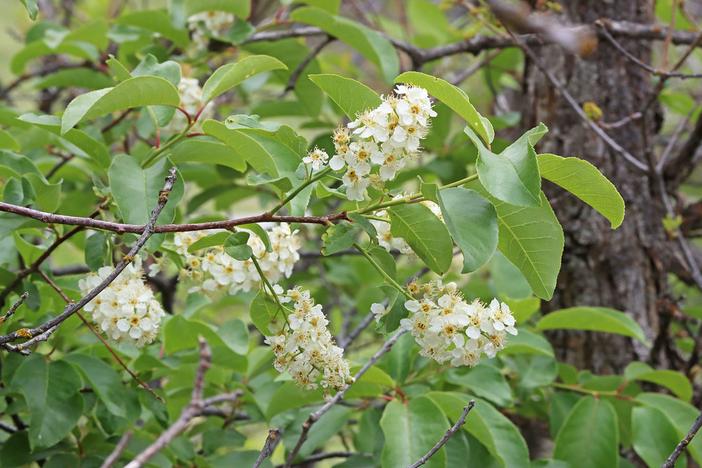Western Chokecherry
(Prunus virginiana var. demissa)
Western Chokecherry (Prunus virginiana var. demissa)
/
/

Andrey Zharkikh
CC BY 2.0
Image By:
Andrey Zharkikh
Recorded By:
Copyright:
CC BY 2.0
Copyright Notice:
Photo by: Andrey Zharkikh | License Type: CC BY 2.0 | License URL: https://creativecommons.org/licenses/by/2.0/ | Uploader: AndreyZharkikh | Publisher: Flickr


































Estimated Native Range
Summary
Prunus virginiana var. demissa, commonly known as Western Chokecherry, is a deciduous shrub or small tree native to a variety of habitats in western and central North America, including forest edges, open woodlands, and riparian zones. It typically grows to a height of 10-30 feet (3-9 meters) with a similar spread, and features a rounded form with dense foliage. The plant produces racemes of small white flowers in late spring, which are moderately showy and attract pollinators. These flowers give way to clusters of dark purple to black cherries in late summer, which are a valuable food source for birds and other wildlife. The bark is gray to reddish-brown and may become scaly with age.
Western Chokecherry is valued for its adaptability to a range of soil types and conditions, including drought tolerance once established. It is often used in naturalized plantings, as a windbreak, or for erosion control. The fruit can be used to make jellies, syrups, and wines, though they are astringent when raw. This plant prefers full sun to part shade and requires well-drained soil. It is relatively low-maintenance but can be susceptible to pests like aphids and diseases such as black knot. Prunus virginiana var. demissa can spread by suckers, potentially forming thickets, and should be managed to prevent unwanted colonization.CC BY-SA 4.0
Western Chokecherry is valued for its adaptability to a range of soil types and conditions, including drought tolerance once established. It is often used in naturalized plantings, as a windbreak, or for erosion control. The fruit can be used to make jellies, syrups, and wines, though they are astringent when raw. This plant prefers full sun to part shade and requires well-drained soil. It is relatively low-maintenance but can be susceptible to pests like aphids and diseases such as black knot. Prunus virginiana var. demissa can spread by suckers, potentially forming thickets, and should be managed to prevent unwanted colonization.CC BY-SA 4.0
Plant Description
- Plant Type: Shrub, Tree
- Height: 10-20 feet
- Width: 10-20 feet
- Growth Rate: Rapid
- Flower Color: White
- Flowering Season: Spring, Summer
- Leaf Retention: Deciduous
Growth Requirements
- Sun: Full Sun, Part Shade
- Water: Medium
- Drainage: Fast, Medium, Slow
Common Uses
Bird Garden, Edible*Disclaimer: Easyscape's listed plant edibility is for informational use. Always verify the safety and proper identification of any plant before consumption., Low Maintenance, Showy Flowers
Natural Habitat
Forest edges, open woodlands, and riparian zones in western and central North America
Other Names
Common Names: Black Chokecherry
Scientific Names: , Prunus virginiana var. demissa, Cerasus demissa, Cerasus demissa, Padus calophylla, Padus demissa, Padus mescaleria, Padus pumicea, Padus valida, Padus virginiana var. demissa
GBIF Accepted Name: